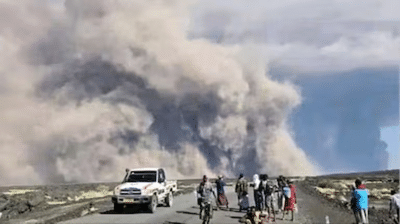
A massive volcanic eruption in Ethiopia has triggered a spreading ash cloud that could soon impact parts of India, including Delhi, Gujarat, Rajasthan, Haryana and Punjab. Weather experts have warned that the plume, generated by the sudden eruption of the Haile Gubbi volcano, is moving rapidly towards the Indian subcontinent and may cause hazy, darkened skies along with disruptions to aviation.
According to the Toulouse Volcanic Ash Advisory Centre, the eruption began on Sunday around 8:30 AM UTC. This event is particularly significant because the Haile Gubbi volcano has shown no recorded activity for nearly 10,000 years, making this its first major eruption in millennia.
Ash Cloud Moving Toward IndiaAs per IndiaMetSky Weather, quoted by ANI, the volcanic ash cloud is expected to enter western India by late Tuesday night. The plume is projected to first drift into Gujarat around 10 PM, followed by Rajasthan and northwest Maharashtra. Overnight, it may also spread toward Delhi NCR, Haryana, Punjab, and parts of the Himalayan belt.
Weather experts say the ash is traveling at a height of 15,000 to 25,000 feet, and in some areas, even up to 45,000 feet. The cloud is moving at an impressive speed of 100–120 km per hour.
What the Ash Cloud ContainsThe drifting plume contains fine volcanic ash, sulfur dioxide, and microscopic fragments of glass and rock. These components can be extremely hazardous—especially for aircraft engines and air quality.
Volcanic ash clouds can reduce visibility, darken the sky, and create a thick haze. IndiaMetSky has cautioned that residents may notice dim, smoky conditions if the ash disperses over major cities.
Air Travel Could Be AffectedAlthough no formal advisory has yet been issued for international flights heading to India, authorities have warned airlines to stay cautious. The ash cloud has the potential to delay flights or force route changes, particularly if visibility reduces or ash concentrations increase.
Satellite imagery reviewed by experts shows a long streak of ash stretching from Ethiopia's volcanic region across the Arabian Sea toward India. While the spread has weakened slightly in recent hours, the threat remains significant as winds continue to push the plume eastward.
A Historic Eruption After 10,000 YearsThe Haile Gubbi volcano lies in the Erta Ale volcanic range of Ethiopia. Scientists estimate that its last major eruption occurred between 10,000 and 12,000 years ago. Its unexpected reactivation has captured global attention, especially as the ash cloud crosses continents.
Initially, the plume drifted westward across the Red Sea, affecting Oman and Yemen. However, shifting winds have redirected the cloud toward the Indian subcontinent.
What to Expect in IndiaIf the ash plume reaches Indian airspace:
Authorities are monitoring the situation closely, and updates are expected throughout the day as the plume moves across regions.